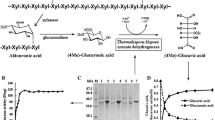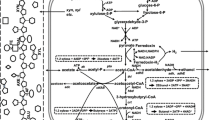Abstract
Xylulokinase (XK, E.C. 2.7.1.17) is one of the key enzymes in xylose metabolism and it is essential for the activation of pentoses for the sustainable production of biocommodities from biomass sugars. The open reading frame (TM0116) from the hyperthermophilic bacterium Thermotoga maritima MSB8 encoding a putative xylulokinase were cloned and expressed in Escherichia coli BL21 Star (DE3) in the Luria–Bertani and auto-inducing high-cell-density media. The basic biochemical properties of this thermophilic XK were characterized. This XK has the optimal temperature of 85 °C. Under a suboptimal condition of 60 °C, the k cat was 83 s−1, and the K m values for xylulose and ATP were 1.24 and 0.71 mM, respectively. We hypothesized that this XK could work on polyphosphate possibly because this ancestral thermophilic microorganism utilizes polyphosphate to regulate the Embden–Meyerhof pathway and its substrate-binding residues are somewhat similar to those of other ATP/polyphosphate-dependent kinases. This XK was found to work on low-cost polyphosphate, exhibiting 41 % of its specific activity on ATP. This first ATP/polyphosphate XK could have a great potential for xylose utilization in thermophilic ethanol-producing microorganisms and cell-free biosystems for low-cost biomanufacturing without the use of ATP.




Similar content being viewed by others
References
Ahmad S, Scopes RK (2002) Isolation and properties of a constitutive d-xylulokinase from a novel thermophilic Saccharococcus caldoxylosilyticus DSM 12041 (ATCC 700356). Enzyme Microb Technol 30(5):627–632. doi:10.1016/s0141-0229(01)00518-x
Anderson RL, Wood WA (1961) Purification and properties of l-xylulokinase. J Biol Chem 237:1029–1033
Arnold K, Bordoli L, Kopp J, Schwede T (2006) The SWISS-MODEL workspace: a web-based environment for protein structure homology modelling. Bioinformatics 22(2):195–201. doi:10.1093/bioinformatics/bti770
Bettiga M, Bengtsson O, Hahn-Hagerdal B, Gorwa-Grauslund M (2009) Arabinose and xylose fermentation by recombinant Saccharomyces cerevisiae expressing a fungal pentose utilization pathway. Microb Cell Fact 8:40
Blanch HW, Simmons BA, Klein-Marcuschamer D (2011) Biomass deconstruction to sugars. Biotechnol J 6(9):1086–1102. doi:10.1002/biot.201000180
Di Luccio E, Petschacher B, Voegtli J, Chou H, Stahlberg H, Nidetzky B, Wilson D (2007) Structural and kinetic studies of induced fit in xylulose kinase from Escherichia coli. J Mol Biol 365:783–798
Ding Y-HR, Ronimus RS, Morgan HW (2001) Thermotoga maritima phosphofructokinases: expression and characterization of two unique enzymes. J Bacteriol 183(2):791–794
Flanagan T, Waites MJ (1992) Purification and characterization of d-xylulokinase from the pentose-fermenting yeast Pichia stipitis NCYC 1541. Enzyme Microb Technol 14:975–979
Guo C, He P, Lu D, Shen A, Jiang N (2006) Cloning and molecular characterization of a gene coding d-xylulokinase (CmXYL3) from Candida maltosa. J Appl Microbiol 101:139–150
Guterl J-K, Garbe D, Carsten J, Steffler F, Sommer B, Reiße S, Philipp A, Haack M, Rühmann B, Kettling U, Brück T, Sieber V (2012) Cell-free metabolic engineering—production of chemicals via minimized reaction cascades. ChemSusChem 5:2165–2172
Guterl J-K, Sieber V (2013) Biosynthesis “debugged”: novel bioproduction strategies. Eng Life Sci 13:4–18. doi:10.1002/elsc.201100231
Hickman J, Ashwell G (1958) Purification and properties of d-xylulokinase in liver. J Biol Chem 232:737–748
Ho NWY, Chang S-F (1989) Cloning of yeast xylulokinase gene by complementation of E. Coli and yeast mutations. Enzyme Microb Technol 11:417–421
Huber R, Langworthy TA, König H, Thomm M, Woese CR, Sleytr UB, Stetter KO (1986) Thermotoga maritima sp. nov. represents a new genus of unique extremely thermophilic Eubacteria growing up to 90°C. Arch Microbiol 144:324–333
Iwanoto S, Motomura K, Shinoda Y, Urata M, Kato J, Takiguchi N, Ohtake H, Hirota R, Kuroda A (2007) Use of an Escherichia coli recombinant producing thermostable polyphosphate kinase as an ATP regenerator to produce fructose 1,6-diphosphate. Appl Environ Microbiol 73(17):5676–5678
Jeon JY, Svenson CJ, Rogers LP (2005) Over-expression of xylulokinase in a xylose-metabolising recombinant strain of Zymomonas mobilis. FEMS Microbiol Lett 244(1):85–92. doi:10.1016/j.femsle.2005.01.025
Jeon YJ, Svenson CJ, Rogers PL (2005) Over-expression of xylulokinase in a xylose-metabolising recombinant strain of Zymomonas mobilis. FEMS Microbiol Lett 244:85–92
Kuhad RC, Gupta R, Khasa Y, Singh A, Zhang Y-HP (2011) Bioethanol production from pentose sugars: current status and future prospects. Renew Sustain Energy Rev 15:4950–4962
Kuroda A, Nomura K, Ohtomo R, Kato J, Ikeda T, Takiguchi N, Ohtake H, Kornberg A (2001) Role of inorganic polyphosphate in promoting ribosomal protein degradation by the Lon protease in E. coli. Science 293(5530):705–708. doi:10.1126/science.1061315
Lee T-H, Kim M-D, Park Y-C, Bae S-M, Ryu Y-W, Seo J-H (2003) Effects of xylulokinase activity on ethanol production from d-xylulose by recombinant Saccharomyces cerevisiae. J Appl Microbiol 95:847–852
Liao HH, Myung S, Zhang Y-HP (2012) One-step purification and immobilization of thermophilic polyphosphate glucokinase from Thermobifida fusca YX: glucose-6-phosphate generation without ATP. Appl Microbiol Biotechnol 93:1109–1117
Martín del Campo JS, Rollin J, Myung S, Chun Y, Chandrayan S, Patiño R, Adams MWW, Zhang YHP (2013) High-yield production of dihydrogen from xylose by using a synthetic enzyme cascade in a cell-free system. Angew Chem Int. doi:10.1002/anie.201300766
Mukai T, Kawai S, Mori S, Mikami B, Murata K (2004) Crystal structure of bacterial inorganic polyphosphate/ATP-glucomannokinase. J Biol Chem 279(48):50591–50600
Myung S, Wang YR, Zhang Y-HP (2010) Fructose-1,6-bisphosphatase from a hyper-thermophilic bacterium Thermotoga maritima: characterization, metabolite stability and its implications. Proc Biochem 45:1882–1887
Myung S, Zhang X-Z, Zhang Y-HP (2011) Ultra-stable phosphoglucose isomerase through immobilization of cellulose-binding module-tagged thermophilic enzyme on low-cost high-capacity cellulosic adsorbent. Biotechnol Prog 27:969–975
Nelson DL, Cox MM (2008) Lehninger principles of biochemistry, 5th edn. WH Freeman, New York
Nelson KE, Clayton RA, Gill SR, Gwinn ML, Dodson RJ, Haft DH, Hickey EK, Peterson JD, Nelson WC, Ketchum KA, McDonald L, Utterback TR, Malek JA, Linher KD, Garrett MM, Stewart AM, Cotton MD, Pratt MS, Phillips CA, Richardson D, Heidelberg J, Sutton GG, Fleischmann RD, Eisen JA, White O, Salzberg SL, Smith HO, Venter JC, Fraser CM (1999) Evidence for lateral gene transfer between Archaea and Bacteria from genome sequence of Thermotoga maritima. Nature 399(6734):323–329
Neuberger MS, Hartley BS, Walker JE (1981) Purification and properties of d-ribulokinase and d-xylulokinase from Klebsiella aerogenes. Biochem J 193:513–524
Resnick SM, Zehander AJB (2000) In vitro ATP regeneration from polyphosphate and AMP by polyphosphate: AMP phosphotransferase and adenylate kinase from Acinetobacter johnsonii 210A. Appl Environ Microbiol 66(5):2045–2051
Rogers TA, Bommarius AS (2010) Utilizing simple biochemical measurements to predict lifetime output of biocatalysts incontinuous isothermal processes. Chem Eng Sci 65:2118–2124
Seiboth B, Metz B (2011) Fungal arabian and l-arabinose metabolism. Appl Microbiol Biotechnol 89:1665–1673
Simpson FJ (1966) d-Xylulokinase. Methods Enzymol 9:454–458
Studier FW (2005) Protein production by auto-induction in high density shaking cultures. Prot Expr Purif 41:207–234
Sun FF, Zhang XZ, Myung S, Zhang Y-HP (2012) Thermophilic Thermotoga maritima ribose-5-phosphate isomerase RpiB: optimized heat treatment purification and basic characterization. Protein Expr Purif 82:302–307
Tang YJ, Sapra R, Joyner D, Hazen TC, Myers S, Reichmuth D, Blanch H, Keasling JD (2009) Analysis of metabolic pathways and fluxes in a newly discovered thermophilic and ethanol-tolerant Geobacillus strain. Biotechnol Bioeng 102(5):1377–1386
Toivari MH, Aristidou A, Ruohonen L, Penttila M (2001) Conversion of xylose to ethanol by recombinant Saccharomyces cerevisiae: importance of xylulokinase (XKS1) and oxygen availability. Metab Eng 3:236–249
vanKuyk PA, de Groot MJ, Ruijter GJ, de Vries RP, Visser J (2001) The Aspergillus niger d-xylulose kinase gene is co-expressed with genes encoding arabinan degrading enzymes, and is essential for growth on d-xylose and l-arabinose. Eur J Biochem 268:5414–5423
Wang R, Zhang L, Wang D, Gao X, Hong J (2011) Identification of a xylulokinase catalyzing xylulose phosphorylation in the xylose metabolic pathway of Kluyveromyces marxianus NBRC1777. J Ind Microbiol Biotechnol 38:1739–1746
Wang Y, Huang W, Sathitsuksanoh N, Zhu Z, Zhang Y-HP (2011) Biohydrogenation from biomass sugar mediated by in vitro synthetic enzymatic pathways. Chem Biol 18:372–380
Wang Y, Zhang Y-HP (2009) Overexpression and simple purification of the Thermotoga maritima 6-phosphogluconate dehydrogenase in Escherichia coli and its application for NADPH regeneration. Microb Cell Fact 8:30
Ye X, Honda K, Sakai T, Okano K, Omasa T, Hirota R, Kuroda A, Ohtake H (2012) Synthetic metabolic engineering-a novel, simple technology for designing a chimeric metabolic pathway. Microb Cell Fact 11(1):120
Ye X, Wang Y, Hopkins RC, Adams MWW, Evans BR, Mielenz JR, Zhang Y-HP (2009) Spontaneous high-yield production of hydrogen from cellulosic materials and water catalyzed by enzyme cocktails. ChemSusChem 2(2):149–152. doi:10.1002/cssc.200900017
You C, Myung S, Zhang Y-HP (2012) Facilitated substrate channeling in a self-assembled trifunctional enzyme complex. Angew Chem Int Ed 51:8787–8790
You C, Zhang X-Z, Zhang Y-HP (2012) Simple Cloning via direct transformation of PCR product (DNA multimer) to Escherichia coli and Bacillus subtilis. Appl Environ Microbiol 78:1593–1595
You C, Zhang Y-HP (2013) Cell-free biosystems for biomanufacturing. Adv Biochem Eng Biotechnol 131:89–119
Zhang M, Eddy C, Deanda K, Finkestein M, Picataggio S (1995) Metabolic engineering of a pentose metabolism pathway in ethanologenic Zymomonas Mobilis. Science 267:240–243
Zhang Y-HP (2011) What is vital (and not vital) to advance economically competitive biofuels production. Proc Biochem 46:2091–2110
Zhang Y-HP, Evans BR, Mielenz JR, Hopkins RC, Adams MWW (2007) High-yield hydrogen production from starch and water by a synthetic enzymatic pathway. PLoS ONE 2(5):e456
Zhang Y-HP, Myung S, You C, Zhu ZG, Rollin J (2011) Toward low-cost biomanufacturing through cell-free synthetic biology: bottom-up design. J Mater Chem 21(47):18877–18886
Zhang YHP (2011) Simpler is better: high-yield and potential low-cost biofuels production through cell-free synthetic pathway biotransformation (SyPaB). ACS Catal 1(9):998–1009. doi:10.1021/cs200218f
Acknowledgments
This work was supported by the Biological Systems Engineering Department of Virginia Tech, and partially supported Shell by GameChanger Program, the CALS Biodesign and Bioprocessing Research Center, and NSF SBIR grant to PZ. JSMC thanks the Mexican Council of Science and Technology (Conacyt) for her PhD study.
Author information
Authors and Affiliations
Corresponding author
Rights and permissions
About this article
Cite this article
Martín del Campo, J.S., Chun, Y., Kim, JE. et al. Discovery and characterization of a novel ATP/polyphosphate xylulokinase from a hyperthermophilic bacterium Thermotoga maritima . J Ind Microbiol Biotechnol 40, 661–669 (2013). https://doi.org/10.1007/s10295-013-1265-7
Received:
Accepted:
Published:
Issue Date:
DOI: https://doi.org/10.1007/s10295-013-1265-7




